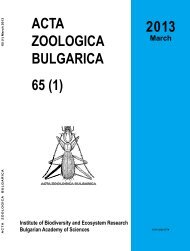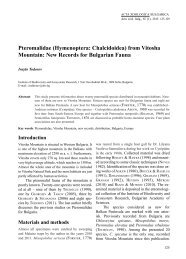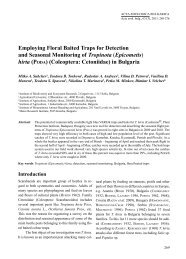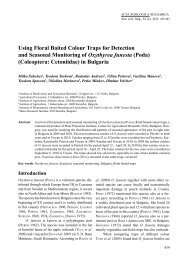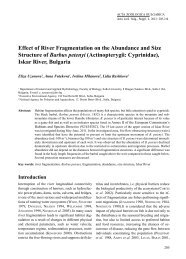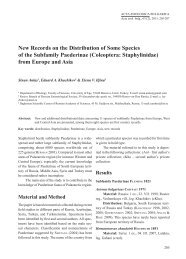First Record of Entomopoxvirus of Ips typographus - Acta zoologica ...
First Record of Entomopoxvirus of Ips typographus - Acta zoologica ...
First Record of Entomopoxvirus of Ips typographus - Acta zoologica ...
You also want an ePaper? Increase the reach of your titles
YUMPU automatically turns print PDFs into web optimized ePapers that Google loves.
Introduction<br />
European spruce bark beetle <strong>Ips</strong> <strong>typographus</strong> is an<br />
economically important pest in the eastern Black Sea<br />
Region <strong>of</strong> Turkey (EROĞLU et al. 2005). Its main host<br />
in this region is Picea orientalis. Various methods<br />
have been used to control this pest, including pheromone<br />
traps, chemical pesticides and mechanical<br />
control strategies (TOPER KAYGIN 2007). However,<br />
these methods are very expensive and complicated.<br />
In addition chemicals control mechanism has harmful<br />
effects on the ecosystem, especially natural enemies<br />
such as predators and parasitoids. Nowadays<br />
environmentalism is getting more popular hence latest<br />
studies have focused on using natural enemies<br />
in biological control (WEGENSTEINER 2004, YAMAN,<br />
RADEK 2005, YAMAN 2007, YAMAN, RADEK 2008).<br />
Most common biological control agent is microorganisms.<br />
Especially entomopathogenic microorganisms<br />
are very effective in decreasing density <strong>of</strong><br />
insect populations (MYERS 1988). Despite several<br />
studies on the parasites and pathogens <strong>of</strong> <strong>Ips</strong> spp.<br />
from different parts <strong>of</strong> the world (WEGENSTEINER,<br />
ACTA ZOOLOGICA BULGARICA<br />
<strong>Acta</strong> zool. bulg., 63 (2), 2011: 199-202<br />
<strong>First</strong> <strong>Record</strong> <strong>of</strong> <strong>Entomopoxvirus</strong> <strong>of</strong> <strong>Ips</strong> <strong>typographus</strong><br />
(Linnaeus) (Coleoptera: Curculionidae, Scolytinae) for Turkey<br />
Mustafa Yaman 1 and Hilal Baki 1,2<br />
1Department <strong>of</strong> Biology, Faculty <strong>of</strong> Sciences, Karadeniz Technical University, 61080, Trabzon, Turkey;<br />
E mail: muyaman@hotmail.com<br />
2Department <strong>of</strong> Biology, Faculty <strong>of</strong> Arts and Sciences, Ordu University, 52200, Ordu, Turkey;<br />
E mail: hilalbakiesk@hotmail.com<br />
Abstract: In present paper, an <strong>Entomopoxvirus</strong> <strong>of</strong> I. <strong>typographus</strong> (ItEPV) in Turkey is reported for fi rst time. <strong>Ips</strong> <strong>typographus</strong><br />
<strong>Entomopoxvirus</strong> was found only in Artvin and the total infection rate was 14.7%. It was observed only<br />
in the gut epithelium <strong>of</strong> the host. Spheroids (inclusion bodies) <strong>of</strong> the virus were rectangular and spherical. The<br />
size <strong>of</strong> rectangular spheroids measured 4 to 10 x 5 to 15 μm and diameter <strong>of</strong> the spherical ones ranged from<br />
7 to 12 μm. <strong>Ips</strong> <strong>typographus</strong> <strong>Entomopoxvirus</strong> infection was also confi rmed with a Transmission Electron<br />
Microscopy. Spherical to elipsoidal virions in spheroids measured 250 to 280 x 310 to 375 nm in size.<br />
Key words: Biological control, <strong>Entomopoxvirus</strong>, <strong>Ips</strong> <strong>typographus</strong>, Turkey<br />
WEISER 1995, WEGENSTEINER et al. 1996, WEISER et<br />
al. 1998, WEISER et al. 2006), there is no record <strong>of</strong> the<br />
pathogens <strong>of</strong> I. <strong>typographus</strong> in Turkey. In the present<br />
study, an entomopoxvirus (ItEPV) <strong>of</strong> I. <strong>typographus</strong><br />
is reported for the fi rst time for Turkey.<br />
Materials and Methods<br />
Adult I. <strong>typographus</strong> specimens were collected from<br />
spruce (Picea orientalis) forests using pheromone<br />
traps in Giresun, Rize and Artvin (Turkey), from May<br />
to August 2009. Each beetle was dissected in Ringer<br />
solution and its intestine was examined microscopically<br />
at magnifi cations <strong>of</strong> 40x to 1000x. Observed<br />
pathogens were measured and photographed using<br />
an Olympus BX 51 microscope with a DP-25 digital<br />
camera and DP2-BSW S<strong>of</strong>t Imaging System.<br />
Samples for (TEM) were fi xed in 2.5% glutaraldehyde<br />
in 0.1 M cacodylate buffer (pH 7.4) for<br />
1–2 h, rinsed in cacodylate buffer, post fi xed in reduced<br />
OsO 4 according to KARNOVSKY (1971) (a<br />
199
Yaman M., H. Baki 1,<br />
fresh 1:1 mixture <strong>of</strong> 2% OsO 4 and 3% K 4 {Fe(CN6)}<br />
1.5 h), and rinsed in cacodylate buffer. After dehydration<br />
in an increasing ethanol series, the infected<br />
beetles were embedded in Spurr’s resin (SPURR<br />
1969). Ultra-thin sections were mounted on<br />
Piol<strong>of</strong>orm-coated copper grids which were stained<br />
with saturated uranyl acetate and Reynold’s lead citrate<br />
(REYNOLDS 1963). They were examined with<br />
TEM microscope.<br />
Results and Discussion<br />
The viral infection was observed in the populations<br />
<strong>of</strong> I. <strong>typographus</strong> in Artvin. During the macroscopic<br />
external observations <strong>of</strong> the infected adults there were<br />
no any visible symptoms confi rming viral infection.<br />
Under light microscope, high number <strong>of</strong> inclusion<br />
bodies (IBs) formed by the virus was observed in the<br />
adult host. Viral inclusion bodies showed the typical<br />
characters <strong>of</strong> entomopoxvirus (EPV) recorded in<br />
bark beetles (WEGENSTEINER, WEISER 1995). The viral<br />
infection was observed only in the gut epithelium<br />
and was not present in other tissues (Fig. 1 A, B).<br />
WEGENSTEINER, WEISER (1995) recorded that EPV in<br />
I. <strong>typographus</strong>, infecting the host midgut epithelium<br />
only, differs from all other EPVs. Viral inclusion<br />
Table 1. The ItEPV infections in <strong>Ips</strong> spp.<br />
Virus Host<br />
ItEPV<br />
ItEPV<br />
200<br />
<strong>Ips</strong> <strong>typographus</strong><br />
<strong>Ips</strong> <strong>typographus</strong><br />
Percent <strong>of</strong><br />
infected individuals<br />
(%)<br />
0.3<br />
1.1<br />
≤0.5 min<br />
18.1 max<br />
Size <strong>of</strong> spheroids<br />
spherical<br />
bodies called spheroids were rectangular and hemispherical<br />
in shape (Fig. 1-B, 2). ItEPV infection was<br />
also confi rmed with TEM. Spherical and elipsoidal<br />
virions in spheroids measured 250 to 280 x 310 to<br />
375 nm in size (Fig. 2 A-D).<br />
Measurement <strong>of</strong> size <strong>of</strong> virions in spheroid in<br />
HÄNDEL et al. (2003), WEGENSTEINER, WEISER (1995)<br />
and our study is different (Table1). It is seen that<br />
there are some morphological differences among<br />
Turkish and European isolates. It is possible that<br />
two different virus strains may occur in Turkey and<br />
in Europe. MURILLO et al. (2001) suggest that some<br />
strains <strong>of</strong> nucleopolyhedrovirus isolated from different<br />
geographies may present better insecticidal activities<br />
which make them more suitable for their host<br />
control and show important differences in biological<br />
activity. Similar judgment is possible for EPV isolates.<br />
Additionally, Asia is a potential source <strong>of</strong> new<br />
and interesting virus strains (MURILLO et al. 2001).<br />
ItEPV was found in adult beetles collected only<br />
from Artvin. Sixty nine <strong>of</strong> the 468 investigated beetles<br />
were infected with ItEPV during three months<br />
(May, June and July). The total rate <strong>of</strong> ItEPV infection<br />
was 14.7% during the three months. Till now,<br />
ItEPV was found only in I. <strong>typographus</strong> and I. amitinus<br />
(WEGENSTEINER, WEISER 1995, TAKOV et al. 2006,<br />
Rectangular<br />
(μm)<br />
Year Locality Literature<br />
5 to 12 4 to 10 x 5 to 11 1993 Austria<br />
- -<br />
1997-1999<br />
Austria<br />
ItEPV <strong>Ips</strong> amitinus 0.3 - 3-14 x5-14 1999 Austria<br />
ItEPV<br />
ItEPV<br />
ItEPV<br />
ItEPV<br />
ItEPV<br />
<strong>Ips</strong> <strong>typographus</strong><br />
<strong>Ips</strong> <strong>typographus</strong><br />
<strong>Ips</strong> <strong>typographus</strong><br />
<strong>Ips</strong> <strong>typographus</strong><br />
<strong>Ips</strong> <strong>typographus</strong><br />
2.3<br />
2.6<br />
9.8<br />
0.9<br />
- 2003-2005 Bulgaria<br />
Wegensteiner<br />
and Weiser, 1995<br />
Händel et al.,<br />
2003<br />
Händel et al.,<br />
2003<br />
Takov et al.,<br />
2006<br />
0.9 - 2007-2008 Georgia<br />
Burjanadze and<br />
Goginashvili,<br />
2009<br />
4.8 - 1995 Germany Wegensteiner<br />
and Weiser, 1996<br />
7.9 - 2003 Bulgaria<br />
14.7 7 to 12<br />
4 to 10 μm x 5<br />
to 15<br />
Takov et al.,<br />
2007<br />
2009 Turkey Present study
<strong>First</strong> <strong>Record</strong> <strong>of</strong> <strong>Entomopoxvirus</strong> <strong>of</strong> <strong>Ips</strong> <strong>typographus</strong> (...<br />
Fig. 1. Spheroids <strong>of</strong> ItEPV from I. <strong>typographus</strong> under light microscope (Bars: A: 20μm, B: 100 μm).<br />
Fig. 2. Spheroids <strong>of</strong> ItEPV from I. <strong>typographus</strong> under TEM Microscope (Bars: A: 1000 nm, B: 1000 nm, C: 400 nm,<br />
D: 200 nm).<br />
201
Yaman M., H. Baki 1,<br />
TAKOV et al. 2007, BURJANADZE, GOGINASHVILI 2009).<br />
According to the results mentioned above the<br />
infection rates were higher in Turkey, Germany and<br />
Bulgaria, but lower in Georgia and Austria. Georgia,<br />
Turkey and Bulgaria are neighbor countries but the<br />
reported infection rates <strong>of</strong> ItEPV were different. To<br />
explain these differences more extensive studies are<br />
needed in this area.<br />
Till now, there is no any virus record from I.<br />
<strong>typographus</strong> in Turkey although Asia is a potential<br />
source <strong>of</strong> new and interesting virus strains (MURILLO<br />
et al. 2001). ItEPV presented here is the fi rst pathogen<br />
<strong>of</strong> I. <strong>typographus</strong> for Turkey and could be an<br />
References<br />
BURJANADZE M., N. GOGINASHVILI 2009. Occurrence <strong>of</strong> Pathogens<br />
and Nematodes in the Spruce Bark Beetles, <strong>Ips</strong> <strong>typographus</strong><br />
(Coleoptera: Scolytidae) in Borjomi Gorge. – Bulletin <strong>of</strong> the<br />
Georgian National Academy <strong>of</strong> Sciences, 3 (1):145-150.<br />
EROĞLU M., H. ALKAN-AKINCI, G. E. ÖZCAN 2005. Kabuk böceği<br />
salgınlarının nedenleri ve boyutları. – Orman ve Av, 82<br />
(5): 27–34.<br />
HÄNDEL U., R. WEGENSTEINER, J. WEISER, Z. ZIZKA 2003. Occurrence<br />
<strong>of</strong> pathogens in associated living bark beetles (Col.,<br />
Scolytidae) from different spruce stands in Austria. – Journal<br />
<strong>of</strong> Pest Sciences, 76: 22-32.<br />
KARNOVSKY M. J. 1971. Use <strong>of</strong> ferrocyanide-reduced osmium<br />
tetroxide in electron microscopy. In: Proc. 14th Ann. Meet.<br />
Am. Soc. Cell Biol. p. 146.<br />
MURILLO R., D. MUNOZ, J.J. LIPA, P. CABALLERO 2001. Biochemical<br />
characterization <strong>of</strong> three nucleopolyhedrovirus isolates <strong>of</strong><br />
Spodoptera exigua and Mamestra brassicae. – Journal <strong>of</strong><br />
Applied Entomology, 125: 267-270.<br />
MYERS J. H. 1988. Can a general hypothesis explain population<br />
cycles <strong>of</strong> forest Lepidoptera. – Advances in Ecological<br />
Research, 18: 179-242.<br />
REYNOLDS E. S. 1963. The use <strong>of</strong> lead citrate at high pH as an<br />
electronopaque stain in electron microscopy. – Journal <strong>of</strong><br />
Cell Biology, 17: 208–212.<br />
SPURR A. R. 1969. A low-viscosity epoxy resin embedding medium<br />
for electron microscopy. – Clinical Microbiology<br />
Research, 3: 197–218.<br />
TAKOV D., D. PILARSKA, R. WEGENSTEINER 2006. Entomopathogens<br />
in <strong>Ips</strong> <strong>typographus</strong> (Coleoptera:Scolytidae) from Several<br />
Spruce Stands in Bulgaria. – <strong>Acta</strong> Zoologica Bulgarıca,<br />
58 (3): 409-420.<br />
TAKOV D, D. DOYCHEV, R. WEGENSTEINER, D. PILARSKA 2007.<br />
Study <strong>of</strong> Bark Beetle (Coleoptera, Scolytidae) Pathogens<br />
from Coniferous stands in Bulgaria. – <strong>Acta</strong> Zoologica<br />
Bulgarıca, 59 (10): 87-96.<br />
TONKA T., J. WEISER, O. PULTAR 2009. <strong>Entomopoxvirus</strong> in the<br />
spruce bark beetle, <strong>Ips</strong> typograhus and its laboratory<br />
management. IUFRO WG 7.03.10 Methodology <strong>of</strong> Forest<br />
Insect and Disease Survey in Central Europe September 15<br />
to 19. Strbske Pleso, Slovakia, 63.<br />
202<br />
alternative biological control agent <strong>of</strong> this insect, because<br />
EPV gives very promising results in biological<br />
control <strong>of</strong> insects. Recently, TONKA et al. (2009)<br />
accomplished to test the laboratory management <strong>of</strong><br />
entomopoxvirus in <strong>Ips</strong> typograhus. They found that<br />
595 <strong>of</strong> the tested 1142 beetles were infected by the<br />
entomopoxvirus. The authors were able to keep this<br />
virus in the laboratory for several weeks.<br />
Acknowledgments: This study was supported by The Research<br />
Foundation <strong>of</strong> Karadeniz Technical University (Project<br />
No 2007.111.004.4). The authors wish to express their thanks to<br />
Pr<strong>of</strong>. Dr. Klaus Hausmann and Dr. Renate Radek for making this<br />
study possible (Institute <strong>of</strong> Biology/Zoology, Free University <strong>of</strong><br />
Berlin, Königin-Luise-Str. 1-3, 14195 Berlin, Germany).<br />
TOPER KAYGIN A. 2007. Endüstriyel odun zararlıları. Nobel<br />
Yayınları. Ankara.<br />
WEGENSTEINER R. 2004. Pathogens in bark beetles. – In: Lieutier<br />
F., Day K. R., Battisti A., Gregoire J. C., Evans H. F. (Eds.):<br />
Bark and wood boring insects in living trees in Europe, a<br />
synthesis. Kluwer, Dordrecht, 291-313.<br />
WEGENSTEINER R., J. WEISER 1995. A new entomopoxvirus in the<br />
bark beetle <strong>Ips</strong> <strong>typographus</strong> (Coleoptera, Scolytidae). –<br />
Journal <strong>of</strong> Invertebrate Pathology, 65: 203-205.<br />
WEGENSTEINER R., J. WEISER 1996. Untersuchungen zum Auftreten<br />
von Pathogenen bei <strong>Ips</strong> <strong>typographus</strong> (Col., Scol.) aus einem<br />
Naturschutzgebiet im Schwarzwald (Baden Württenberg)<br />
(in German). – Anzeiger für. Schädlingkunde, Pfl anzenschutz,<br />
Umweltschutz, 69: 162-167.<br />
WEGENSTEINER R., J. WEISER, E. FÜHRER 1996. Observations on the<br />
occurrence <strong>of</strong> pathogens in the bark beetle <strong>Ips</strong> <strong>typographus</strong><br />
L. (Coleoptera. Scolytidae). – Journal <strong>of</strong> Applied Entomology,<br />
120: 199-204.<br />
WEISER J., R. WEGENSTEINER, Z. ZIZKA 1998. Unikaryon montanum<br />
sp.n. (Protista: Microspora), a new pathogen <strong>of</strong> the spruce<br />
bark beetle <strong>Ips</strong> <strong>typographus</strong> (Coleoptera: Scolytidae). –<br />
Folia Parasitologica, 45: 191-195.<br />
WEISER J., J. HOLUSA, Z. ZIZKA 2006. Larssoniella duplicati<br />
n.sp. (Microsporidia. Unikaryonidae), a newly described<br />
pathogen infecting the double-spined spruce bark beetle, <strong>Ips</strong><br />
duplicatus (Coleoptera, Scolytidae) in the Czech Republic.<br />
– Journal <strong>of</strong> Pest Science, 79: 127-135.<br />
YAMAN M., R. RADEK 2005. Helicosporidium infection <strong>of</strong> the<br />
great Europen spruce bark beetle, Dendroctonus micans<br />
(Coleoptera. Scolytidae). – European Journal <strong>of</strong> Protistology,<br />
41: 203-207.<br />
YAMAN M. 2007. Gregarina typographi Fuchs, a Gregarine Pathogen<br />
<strong>of</strong> the Six-Toothed Pine Bark Beetle, <strong>Ips</strong> sexdentatus<br />
(Boerner) (Coleoptera: Curculionidae, Scolytinae) in Turkey.<br />
-Turkish Journal <strong>of</strong> Zoology, 31: 359-363.<br />
YAMAN M., R. RADEK 2008. Identification, distribution and<br />
occurence <strong>of</strong> the ascomycete fungus Metschnikowia typographi<br />
in the great spruce bark beetle, Dendroctonus<br />
micans. – Folia Microbiologica, 53: 427-432.<br />
Received: 12.02.2011<br />
Accepted: 11.03.2011



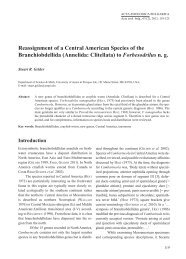
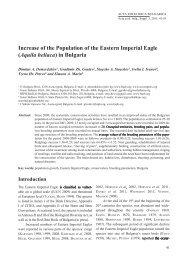
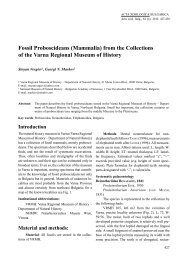
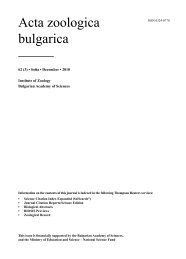
![table of contents [PDF] - Acta zoologica bulgarica](https://img.yumpu.com/52655254/1/186x260/table-of-contents-pdf-acta-zoologica-bulgarica.jpg?quality=85)
![table of contents [PDF] - Acta zoologica bulgarica](https://img.yumpu.com/52655255/1/186x260/table-of-contents-pdf-acta-zoologica-bulgarica.jpg?quality=85)
